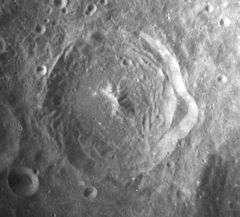Green (lunar crater)
|
| |
| Coordinates | 4°06′N 132°54′E / 4.1°N 132.9°ECoordinates: 4°06′N 132°54′E / 4.1°N 132.9°E |
|---|---|
| Diameter | 65 km |
| Depth | Unknown |
| Colongitude | 228° at sunrise |
| Eponym | George Green |

Green is a lunar impact crater on the Moon's far side. It lies just to the west of the huge walled plain Mendeleev, and is nearly joined with the west-northwestern edge of the crater Hartmann.
The crater has not been significantly eroded although a few tiny craterlets lie along the edge and inner wall. The perimeter is nearly circular, but has an outward bulge along the eastern side with some indications of a landslip. The inner sides display some terrace structures, particularly to the northeast. At the midpoint of the relatively level interior floor is a central ridge. The floor is more level along the western half, with some low rises in the east. There are only a few tiny craterlets on the interior.
Prior to naming in 1970,[1] this crater was known as Crater 216.[2]
Satellite craters
By convention these features are identified on lunar maps by placing the letter on the side of the crater midpoint that is closest to Green.
| Green | Latitude | Longitude | Diameter |
|---|---|---|---|
| M | 0.9° N | 132.9° E | 37 km |
| P | 1.0° N | 131.8° E | 21 km |
| Q | 2.8° N | 131.7° E | 16 km |
| R | 3.4° N | 131.0° E | 33 km |
 Green M crater from Apollo 11
Green M crater from Apollo 11
Green M crater has a ray system and is consequently mapped as part of the Copernican system.[3]
References
- ↑ Green, Gazetteer of Planetary Nomenclature, International Astronomical Union (IAU) Working Group for Planetary System Nomenclature (WGPSN)
- ↑ Lunar Farside Chart (LFC-1A)
- ↑ Stratigraphy of Lunar Craters, Don E. Wilhelms and Charles J. Byrne, January 23, 2009
- Andersson, L. E.; Whitaker, E. A. (1982). NASA Catalogue of Lunar Nomenclature. NASA RP-1097.
- Blue, Jennifer (July 25, 2007). "Gazetteer of Planetary Nomenclature". USGS. Retrieved 2007-08-05.
- Bussey, B.; Spudis, P. (2004). The Clementine Atlas of the Moon. New York: Cambridge University Press. ISBN 978-0-521-81528-4.
- Cocks, Elijah E.; Cocks, Josiah C. (1995). Who's Who on the Moon: A Biographical Dictionary of Lunar Nomenclature. Tudor Publishers. ISBN 978-0-936389-27-1.
- McDowell, Jonathan (July 15, 2007). "Lunar Nomenclature". Jonathan's Space Report. Retrieved 2007-10-24.
- Menzel, D. H.; Minnaert, M.; Levin, B.; Dollfus, A.; Bell, B. (1971). "Report on Lunar Nomenclature by the Working Group of Commission 17 of the IAU". Space Science Reviews. 12 (2): 136–186. Bibcode:1971SSRv...12..136M. doi:10.1007/BF00171763.
- Moore, Patrick (2001). On the Moon. Sterling Publishing Co. ISBN 978-0-304-35469-6.
- Price, Fred W. (1988). The Moon Observer's Handbook. Cambridge University Press. ISBN 978-0-521-33500-3.
- Rükl, Antonín (1990). Atlas of the Moon. Kalmbach Books. ISBN 978-0-913135-17-4.
- Webb, Rev. T. W. (1962). Celestial Objects for Common Telescopes (6th revised ed.). Dover. ISBN 978-0-486-20917-3.
- Whitaker, Ewen A. (1999). Mapping and Naming the Moon. Cambridge University Press. ISBN 978-0-521-62248-6.
- Wlasuk, Peter T. (2000). Observing the Moon. Springer. ISBN 978-1-85233-193-1.

